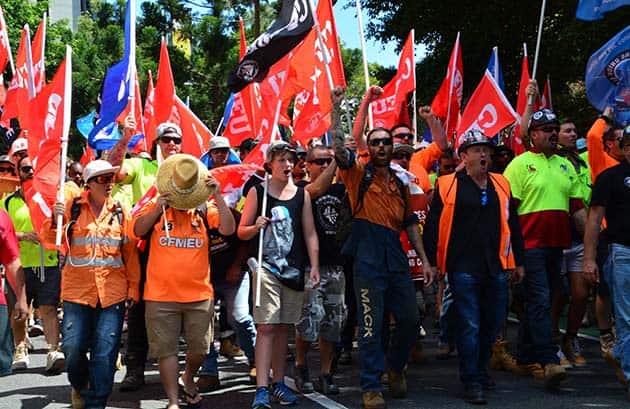The talk of union amalgamations and the latest statistics on union membership have again raised the question of how to build unions.
The CFMEU and MUA may merge to form a “super union” according to MUA Secretary Paddy Crumlin. The TCFUA also wants to merge with the CFMEU. There is also talk of the left-wing AMWU and the right-wing AWU amalgamating.
Most unionists see this as a great thing in that “bigger is better”. The Coalition described the merger of the MUA and CFMEU as a “disaster”, arguing it will lead to a more powerful and militant union.
New figures from the Australian Bureau of Statistics say just 15.1 per cent of the workforce are now union members, and just 11 per cent in private sector. Rightly the ACTU pointed out that unions still represent 1.8 million members, and are the single large voluntary organisations in Australia.
But over the past two decades union membership has declined from 43 per cent of the workforce in 1992.
But amalgamations are not the answer to rebuilding the union movement.
Nor are talk-fests, as ACTU Secretary Dave Oliver said “Next month union leaders will be gathering for the Australia Disrupted Symposium to discuss the future of work and how we can best represent workers no matter who they are or how they work.”
Unions are built through strikes and industrial action. When unions take action they recruit new members. The Victorian nurses’ union recruited almost 6000 members through its industrial campaign in 2011. The ETU in Victoria has grown from 8500 members in 1995 to 19,000 today under a militant leadership not afraid to take strike action.
The idea that amalgamations could help turn around declining membership is not new. Between 1991 and 1996 the number of unions more than halved through amalgamations. Union membership continued to decline.
Nor is it automatic that bigger unions will lead to solidarity. The MUA was formed through amalgamating the Seamen’s Union of Australia representing seafarers and the Waterside Workers Federation representing dock workers. But officials effectively told the seafarers to scab on wharfies during the Patrick lockout of 1998, despite seafarers wanting to walk out in their support.
The white-collar CPSU has built a “super union” by merging state-based public service unions, but has become more bureaucratised and now has less active delegates’ structures.
Similarly, the AEU Victorian branch now incorporates primary school and secondary school teachers, teachers’ aides, other support staff and principals. The AEU calls mass meetings at the start of bargaining but not at the end to ratify a new agreement.
Big unions are a short-cut for the hard yards of recruiting people and too often a cover for officials too politically timid to break anti-strike laws, whether it be the MUA in 1998 or the CFMEU today, which has paid millions in fines rather than argue to break the law.
By Tom Orsag






